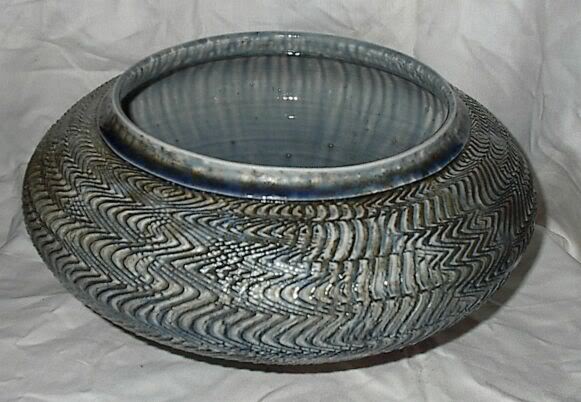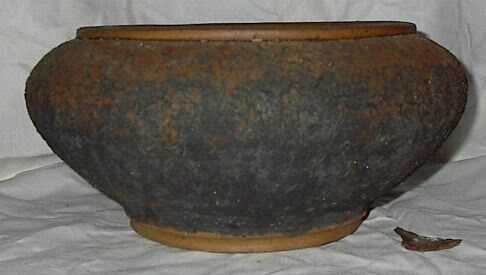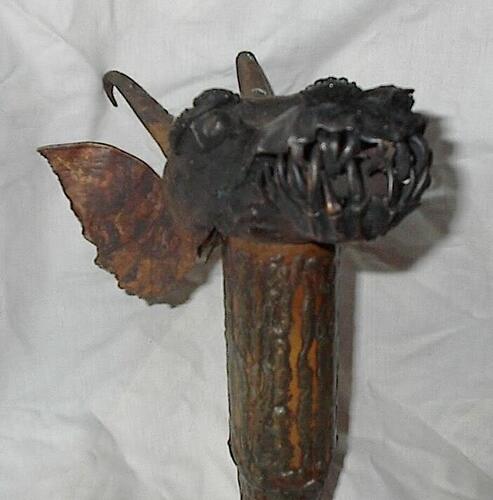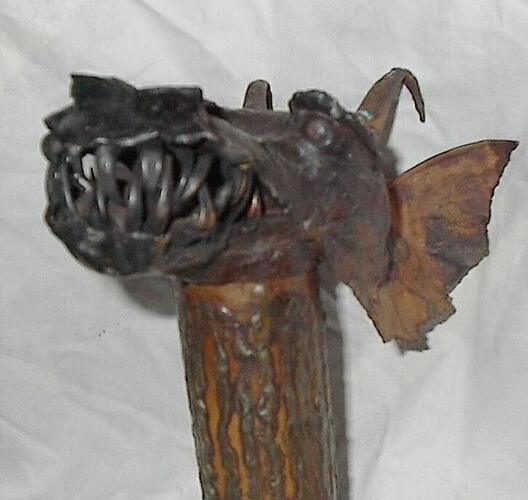I actually have my Mad Hatter at work and only run him during the work day (so, maybe 8 hours at a stretch). Seems to last 3 - 4 days before needing to be recharged.
What plastic coat product did you use?
Perhaps you had created a new type…wire warp. ![]()
Styrospray 1000. However - bushed on - not sprayed
Wow, Number 2265 Ill bet fewer folk get that than “first” so many exquisite things. Like many using a robot to create artwork, I started that before there were computers to help. I was doing 3D printing of gold jewelry but as there was no computer to help had to do it by hand. Most that I made was done that way but few photographs have survived, the far upper left here is lost wax gold, the rest is hand built silver, the stones that look painted on are inlay.
Some other stuff
I did a lot of work with welded copper,
Other folk have dragons about but I had one on my staff.
Some other close-ups are here
and then there is the drunk hanging about

and some stoneware and porcelain bowls (the textures are part of the throwing process)
each around 18 inches across.


Thank you! That’s what I’ve told others on a number of occasions. Working in IT and always dealing with the non-tangible, virtual world just leaves me with more and more appreciation for the physical one.
All of that is great! The pots… I have always thought a potter’s wheel would be a meditative medium for expression. That texture is marvelous. 
So you have a kiln big enough for that, kilnsitter and all? I had a very small kiln outfitted with a sitter, but eventually upgraded to a pyrometer. Did some enameling but mostly used the kiln for wax burnout for precious metal centrifugal casting. Never turned to potting.
Stained glass is another discipline that I always admired. Someday perhaps.
@rbtdanforth, pro metalwork there man, beautiful! 

Unfortunately the pottery was done when I was a member of the Miami Ceramic League and they had the big reduction oven. As a 501c3 corporation folk could donate there big electric kilns and potters wheels and take the tax break, so there was a lot of those.
They raised donations for someone to show them how to do the big reduction kiln and of course at the end of the class they had the kiln. They also bought clay and chemicals in bulk so if you only needed a gram of a chemical you paid for that gram and not the kilo that it came as.
They also paid visiting teachers to teach classes and the had the most amazing gallery of those teachers work that highlighted what was taught.
I had a big electric kiln I used to make slumped glass bowls and dishes and of course the burnout oven for casting. I also still have my tools for furnace glass (pipe, punties, jacks etc, and lots more but no furnace or glory hole 
I had a special style of throwing that was very dry but took a wheel with a worm drive to provide the needed torque and roller based tools to cut back on the friction that way the work was strong even very thin as those bowls are a millimeter to two millimeters thick through much of their body (thicker in the high points of the texture but the porcelain bowl will pass light from inside.
The most addicting work is furnace Glass! As it is a liquid at all times and takes total attention. Much like a Tai Chi kata every move will have a result in the glass and how you place each toe counts in the result. Gravity has a huge influence in your work and most cases if you are not done in 15 to 20 min you will probably get nothing. Many great pieces take only 5 min but every move must be perfect.
Even throwing on the wheel you can take a break or even have lunch, but you cannot have a moments inattention with glass.
It is also frightfully expensive costing a few thousand a month if you make good or not.
Have you looked at the Dragon furnaces from mobileglassblowing in Atlanta? They combine 2 furnaces and allow you to run them off of propane in shorter sessions so you’re not heating the furnace 24/7 and only using it for a few hours. Lower capacity than the big hard-piped gas ones but for a small artisan they can make sense.
Also pricey and a tank used as a glory hole is common if not so good idea, which is what they are talking about. It will come to heat in the two hours but I expect it would take three or more if you don’t want bubbles. the biggest problem no matter what size you are working with is shutting down, as the tank must be cleaned of all glass before shutting down or it will look like a bomb went off inside the tank.
I worked with such a setup and lots of bits of tank in your glass is not a good thing! the coefficient of expansion of the glass is about 100 times that of the tank which is fine as long as the glass is liquid but as it solidifies and cools it gets smaller than the same bit of tank which is not a huge problem if the layer of glass is very thin but much bigger if it is thick or a whole volume. This is why most run 24/7 and why the energy bill is so high.
Interesting. I agree on the heating time. But I’m surprised it would be so problematic to shutdown considering how many of them that are out there and when I’ve seen them used it wasn’t mentioned as an issue. Was considering one for the workshop ![]()
It is fine to have one and plan on running 24/7 but I would build my own for much cheaper than they are selling them (and better too) I would make a pot furnace with a cubic zirconium pot (this is not the jewelry cubic zirconium but a clay made from the same minerals). It is extremely strong and will not crack as it is heated as other types can, it will also dissolve in the glass so little as to not be noticed, while everything else dissolves much faster.
Basicly glass at heat is the universal solvent and will dissolve everything eventually. A well-insulated pot furnace can save far more than the extra costs in gas. An alternative is silicon carbide rods and an arc welder. The rods are relatively cheap but to save them you can pay huge amounts for the perfect square wave driver, but I saw the setup with arc welders and they claimed they worked fine
As you can find used arc welders very cheap that would be a way to go. You would want to keep the fumes away from the connections as sodium and lithium do volatile out of the glass (also making the glass stiffer and lower coefficient of expansion over time if you are not blowing for weeks). I have seen those problems as well.
They do have a nice controller for the annealing oven at the dragon place, but I googled it and it is only $400.00. As the glory hole is only running while you are blowing glass you can make that bigger out of a ceramic fiber lined 30gal drum with a layer of mullite to keep the fiber from dissolving in bits of glass.
Another point is that ceramic fiber is high in insulation but has little heat inertia while firebrick has lots of inertia and much less insulation. For basic structure, there are many YouTube videos on making foam concrete, but the secret ingredient used by commercial folk is aluminum powder so I would check that out first. The foam concrete wants heat to cure properly so I would use a commercial steam cleaner to get the temp up there.
Why foam Concrete? Because you can put a torch on it without any spelling or cracking, so it makes an ideal outer material to make ovens out of. It won’t stand up to glass temps but with ceramic fiber lining, it will not sag as steel that is only slightly elevated will.
I worked for a time for Medieval Times in Orlando and learned a lot what not to do. They did have the finest set of annealing ovens and an industrial computer that could keep track of five ovens on different schedules but as the method was a bit obscure nobody had ever used it or the annealers for anything but tables. They were galvanized steel boxes with heavy ceramic fiber lining of excellent design and build.
The tank furnace was more or less standard but it was exactly what you would expect from letting the glass get cold, and the many holes were rapidly dissolving the firebrick behind the tank with the glass flowing in when filled and back into the tank as the glass was used bringing lots of bits of firebrick with it. They had also been using the tank as a forge so lots of rust flakes in the glass as well.
The Glory Hole (which can double as a forge if you are not too lazy to turn it on) had the blower at the back so folk would go back there to get the heat and melt the pipe heads off all the blowpipes.
As they would not pat more than $5.00 an hour for a ten hour week, they did not get the best glassblowers. I had taken the job just to be able to have the equipment and I was temporarily out of work where there was 4-5 times that much for 40 hour weeks with lots of overtime. It actually cost me to have the job but I did not mind, and I worked many hours that I was not paid at all just to be ab;e to work with the furnace.
When I did find that other job and wanted to set my schedule around it they fired me and said they would never hire me again. Realizing what it took to manage the equipment they dumped it making sure I could not find the annealers as I would have paid well for them.
Nice people ![]()
Definitely- was a Spanish Count who thought to have a museum using the junk peasants were still using recently but was as much as 800 years old to illustrate what medieval times were like with the wood, fabric, metal, and glass demonstrated but found that the real money was in cheap food while folk watched “Knights” joust. The museum had a torture chamber of refabricated fakes but the impression was that these were English designs and no mention of the Spanish Inquisition.
He did so well he franchised the business out, but the fake torture chamber was all that was used from the museum.
Birthday dinner for my wife. She requested steak and Risotto. So…
Dry-aged ribeye, bacon and Pea Risotto, and maple roasted Brussels sprouts!
My wife prefers Pie to Cake, so I bought her a mini Key-Lime Pie. It was supposed to be a surprise, but when I got back from the store, the first quest I got was “Did you get something for dessert?”
Bullseye man! (mouth watering)
You know how to treat a woman. My Wife would faint if I cooked something.
Does she rent you out? 



